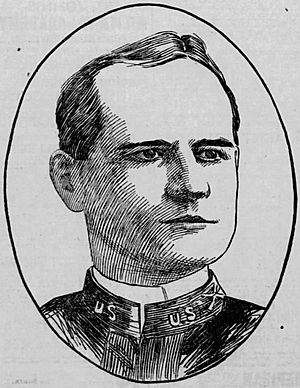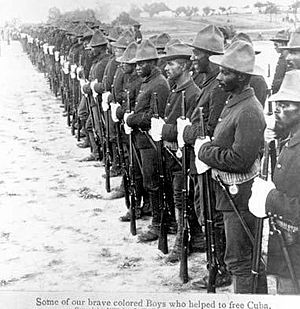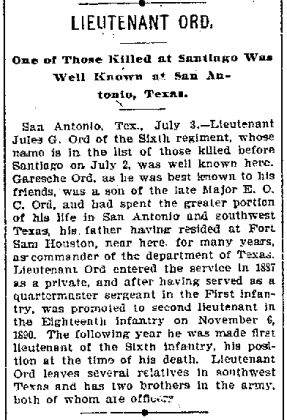Jules Garesche Ord facts for kids
Quick facts for kids
Jules Garesche Ord
|
|
|---|---|

Chicago Tribune, August 8, 1898
|
|
| Nickname(s) | Gary |
| Born | September 9, 1866 Michigan, US |
| Died | July 1, 1898 (aged 31) San Juan Hill, near Santiago, Cuba |
| Place of burial | |
| Allegiance | |
| Service/ |
|
| Years of service | 1887–1898 |
| Rank | First Lieutenant |
| Battles/wars | Indian Wars Spanish–American War |
| Relations | Edward Ord, father Edward Otho Cresap Ord, II, brother James Garesche Ord (nephew) |
Jules Garesche "Gary" Ord (born September 9, 1866 – died July 1, 1898) was a brave United States Army officer. He was a First Lieutenant who led a famous charge during the Spanish–American War in Cuba. On July 1, 1898, he led the Buffalo Soldiers of the 10th U.S. Cavalry up San Juan Hill. Many historians now believe that Lieutenant Ord was key to this important charge that helped the U.S. win the San Juan Heights.
Contents
Growing Up: Gary Ord's Early Life
Jules Garesche Ord was the youngest of 15 children. His family called him "Young Garesche." He was born in Michigan in 1866.
His father, Edward Otho Cresap Ord, was a military officer. He was a hero in the American Civil War. His mother was Mary Mercer Thompson.
Gary grew up in a privileged home. His father was a respected general. The family lived in places like San Francisco, California, and San Antonio, Texas. Gary had tutors and servants.
In 1880, his father retired from the Army. He had served for 41 years. Gary struggled a bit with school. In 1883, his father sadly died from yellow fever in Havana, Cuba.
Joining the Army: Gary's Military Service
On August 16, 1887, Gary decided to join the Army. He first enlisted as a Private. People quickly noticed his leadership skills. He moved up in rank to Quartermaster Sergeant.
In 1890, he passed a tough exam. This allowed him to become a Second Lieutenant. He was promoted to First Lieutenant in 1897.
When the Spanish–American War started in 1898, Ord volunteered for duty in Cuba. He became an aide to Brigadier General Hamilton S. Hawkins. Many officers got sick during the war. Ord wanted to be in the action. He asked to join D Troop of the "Buffalo Soldiers" 10th U.S. Cavalry. A family friend, John Bigelow Jr., was in command there.
Before his last battle, Ord told Bigelow something important. He said he would come out of the fight as a "colonel or a corpse."
The Battle of San Juan Hill: A Key Moment
The San Juan Heights were a very important location. They included San Juan Hill and Kettle Hill. These hills were the last major obstacle for the American forces. They were located about a mile east of Santiago, Cuba.
Clearing Up Myths About the Battle
Many stories have been told about this battle. One famous story is about the Rough Riders and Colonel Theodore Roosevelt. They claimed to have taken Kettle Hill. But the truth is, regular Army soldiers, including the "black" 10th Cavalry, were key. They were supported by the 3rd Cavalry and Roosevelt's Rough Riders.
Most of the 10th Cavalry, along with parts of the 24th and 25th Infantry, took San Juan Hill. This was the main Spanish defense. The 10th Cavalry was in the middle of the American attack. When they moved forward, they split to attack both hills.
Roosevelt claimed he started the charge up Kettle Hill. But he actually joined "the regulars" after Lieutenant Ord asked him to. Sergeant George Berry of the 10th Cavalry was first to reach the top of Kettle Hill. He placed his regiment's flag there. This was before the Rough Riders' flag arrived. This is supported by John J. "Black Jack" Pershing, who fought with the 10th.
The Main Attack: Leading the Charge
On July 1, 1898, Captain Bigelow of the 10th Cavalry was waiting for orders. His troops were under heavy fire from the Spanish. Other American units were in position, but no one was ordered to attack.
Lieutenant Ord was serving as an aide to General Hawkins. He volunteered to go to the front lines. Ord went to General Hawkins to ask for permission to attack.
Here is what Captain John Bigelow, Jr. wrote in a letter home:
—I sent Jules to General Hawkins to ask for an attack. He asked, "General, if you will order a charge, I will lead it."
The General might have remembered costly charges from past wars. He might have hesitated. Jules then said, "If you do not wish to order a charge, General, I would like to volunteer." After another pause, he pleaded, "May I volunteer? We can't stay here, can we?"
"I would not ask any man to volunteer," was the reply. "If you do not forbid it, I will start it," Jules answered.
The General looked toward the Heights. He said the brigades were not all ready. General Hawkins told me he felt terrible looking at Jules. But Jules firmly said, "I only ask you not to refuse permission." The reply was, "I will not ask for volunteers, I will not give permission and I will not refuse it."
Jules saluted smartly with a broad smile. As Jules left, the old General called out, "God bless you and good luck!"...
The General told me he knew the fight would be costly. But Jules had taken a weight off his shoulders.
—
- Captain John Bigelow, Jr., 10th U.S. Cavalry, D Troop in a letter home.
Ord then went to other officers. He encouraged them to support the charge. When he reached D Troop, he was out of breath but smiling. He told Captain Bigelow what happened. He asked for permission to give the command. Bigelow agreed.
Ord pulled out his revolver and sword. He stood up and yelled, "Forward!" He bravely started walking up the hill.
The Buffalo Soldiers of the 10th Cavalry rose up. They began to charge toward the steep hills. Ord kept going through heavy enemy fire. He was heard yelling, "Come on—come on, you fellows! Come on—we can't stop now."
About 150 yards from the top, the men rushed forward. Captain Bigelow was hit by bullets but kept urging his men on. He was hit three more times and fell. Soldiers heard him say, "Men, don't stop for me, just keep up the charge until you get to the top of the hill." His men reached the top. They took the main blockhouse and helped their comrades.
Lieutenant Ord was reportedly the first officer to reach the top. As he directed fire, he was shot in the throat. He was badly wounded. He dropped his pistol and sword. Corporal Walker of D Troop killed the Spanish soldier who shot Ord. Walker tried to help Ord. Ord made a statement before he died. He believed that if the 10th Cavalry had not been split, they would have taken the heights even faster. Ord was buried on the hill.
First Sergeant Givens then took command of D Troop. He held their position. Major "Black Jack" John J. Pershing later took temporary command. On that day, half of the 10th Cavalry's officers and one-fifth of its soldiers were killed or wounded.
After the Battle: What Happened Next
Lieutenant Gary Ord did not receive a medal for his bravery at San Juan Hill. The Army turned down requests for a medal. This was partly because he was listed as an aide to his general, not a front-line officer.
Sadly, his father, General E.O.C. Ord, had also died in Havana, Cuba, from yellow fever in 1883. Both father and son are buried at Arlington National Cemetery.
Gary's brother, Captain Edward Otho Cresap Ord, II, also fought at Santiago. He also got yellow fever. He survived but needed a long break from the Army.
Colonel Theodore Roosevelt of the Rough Riders was widely credited with starting the charge up San Juan Heights. However, he only went up the smaller Kettle Hill. Roosevelt was later awarded the Medal of Honor in 2001. But there was no mention of Lieutenant Jules G. Ord or the 10th Cavalry Regiment in his award.
Images for kids
-
Chicago Tribune, August 8, 1898





